American History 英美概况美国历史
英美概况美国部分初稿
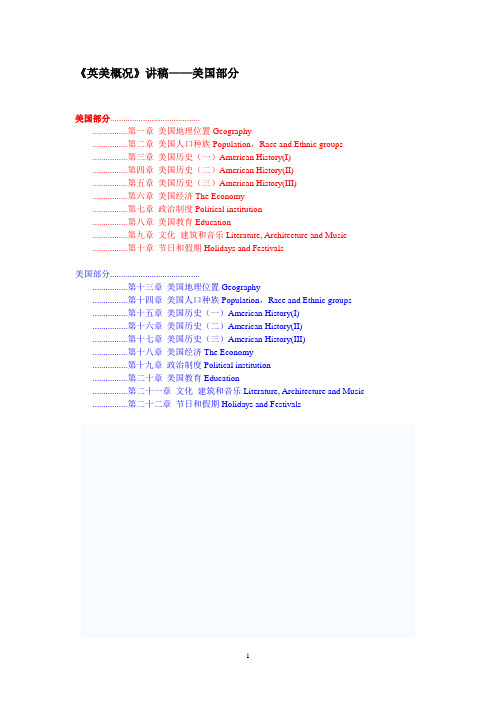
《英美概况》讲稿——美国部分美国部分.........................................................第一章美国地理位置Geography................第二章美国人口种族Population,Race and Ethnic groups................第三章美国历史(一)American History(I)................第四章美国历史(二)American History(II)................第五章美国历史(三)American History(III)................第六章美国经济The Economy................第七章政治制度Political institution................第八章美国教育Education................第九章文化建筑和音乐Literature, Architecture and Music................第十章节日和假期Holidays and Festivals美国部分.........................................................第十三章美国地理位置Geography................第十四章美国人口种族Population,Race and Ethnic groups................第十五章美国历史(一)American History(I)................第十六章美国历史(二)American History(II)................第十七章美国历史(三)American History(III)................第十八章美国经济The Economy................第十九章政治制度Political institution................第二十章美国教育Education................第二十一章文化建筑和音乐Literature, Architecture and Music ................第二十二章节日和假期Holidays and Festivals英美概况精讲——美国部分Chapter 1 geography 地理位置1.Alaska and Hawaii are the two newest states in American. Alaska northwestern Canada,and Hawaii lies in the central Pacific.阿拉斯加和夏威夷是最近加入美国的两个新州。
American History
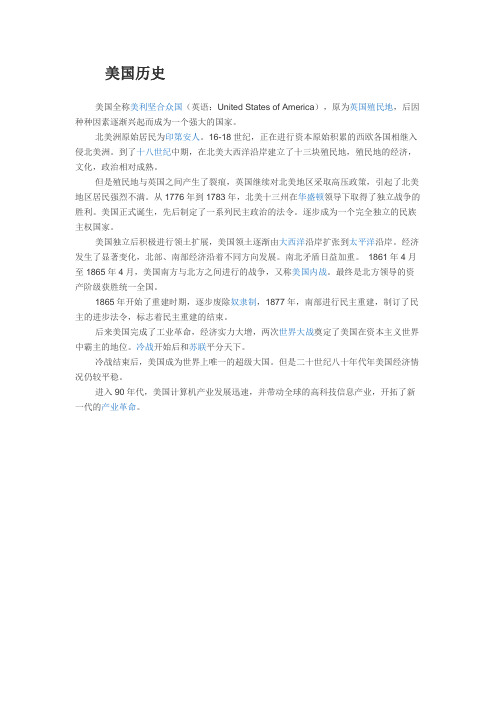
美国历史
美国全称美利坚合众国(英语:United States of America),原为英国殖民地,后因种种因素逐渐兴起而成为一个强大的国家。
北美洲原始居民为印第安人。
16-18世纪,正在进行资本原始积累的西欧各国相继入侵北美洲。
到了十八世纪中期,在北美大西洋沿岸建立了十三块殖民地,殖民地的经济,文化,政治相对成熟。
但是殖民地与英国之间产生了裂痕,英国继续对北美地区采取高压政策,引起了北美地区居民强烈不满。
从1776年到1783年,北美十三州在华盛顿领导下取得了独立战争的胜利。
美国正式诞生,先后制定了一系列民主政治的法令。
逐步成为一个完全独立的民族主权国家。
美国独立后积极进行领土扩展,美国领土逐渐由大西洋沿岸扩张到太平洋沿岸。
经济发生了显著变化,北部、南部经济沿着不同方向发展。
南北矛盾日益加重。
1861年4月至1865年4月,美国南方与北方之间进行的战争,又称美国内战。
最终是北方领导的资产阶级获胜统一全国。
1865年开始了重建时期,逐步废除奴隶制,1877年,南部进行民主重建,制订了民主的进步法令,标志着民主重建的结束。
后来美国完成了工业革命,经济实力大增,两次世界大战奠定了美国在资本主义世界中霸主的地位。
冷战开始后和苏联平分天下。
冷战结束后,美国成为世界上唯一的超级大国。
但是二十世纪八十年代年美国经济情况仍较平稳。
进入90年代,美国计算机产业发展迅速,并带动全球的高科技信息产业,开拓了新一代的产业革命。
英美概况知识点总结归纳

英美概况知识点总结归纳英美概况是指英国和美国的文化、历史、政治、经济、教育等各方面的概况。
这两个国家在世界上具有重要的地位,对世界文化和政治产生了深远的影响。
下面将对英美概况的各个方面进行总结归纳。
一、文化概况1. 英国文化英国是一个拥有悠久历史的国家,其文化底蕴深厚。
英国文学自古至今在世界范围内具有重要地位,莎士比亚、狄更斯、奥斯丁等众多文学家的作品至今仍然备受人们喜爱。
英国音乐、戏剧、电影等领域也有着丰富的传统。
2. 美国文化美国是一个移民国家,因此其文化融合了来自世界各地的元素,呈现出多元化和包容性。
美国文学、音乐、电影等在世界上具有很大影响力,如杰克·伦敦、海明威、福克纳等作家的作品、爵士乐、摇滚乐、好莱坞电影等都深受人们喜爱。
3. 英美文化交流英美两国之间的文化交流十分频繁,互相影响。
英国音乐、戏剧、文学等在美国具有很大影响力,而美国的流行音乐、电影、文化现象也在英国广受欢迎。
二、历史概况1. 英国历史英国历史可以追溯到古代,罗马、盎格鲁-撒克逊、诺曼底人等不同民族和文化在英国留下了深远的影响。
英国从16世纪开始成为世界上的帝国大国,殖民了大量领土。
20世纪初,英国逐渐衰落,但仍然在政治、文化方面占有重要地位。
2. 美国历史美国历史相对年轻,但是却是一个充满传奇色彩的国家。
美国独立战争后成为独立国家,并在19世纪成为世界上最强大的国家之一。
20世纪,美国在两次世界大战后成为世界超级大国,对世界政治、经济产生了深远影响。
3. 英美历史关系英国曾是美国的殖民地,双方有着深厚的历史渊源。
美国革命后,两国保持了密切的关系,经济、文化、政治等方面有着广泛的交流合作。
三、政治概况1. 英国政治英国是一个君主立宪制国家,国家元首是君主,首相是政府首脑。
英国的政治体系成熟稳定,经过数百年的发展,形成了一套完善的议会制度和法律体系。
2. 美国政治美国是一个总统制国家,总统是国家元首和政府首脑。
美国4历史2 美国概况 英语国家概况 英美概况课件

The Monroe Doctrine
❖ The Monroe Doctrine is a U.S. doctrine which, on December 2, 1823, stated that European powers were no longer to colonize or interfere with the affairs of the newly independent states of the Americas.
❖ The United States would not interfere with existing colonies or their dependencies in the Western Hemisphere. However, any attempt by a European nation to oppress or control any nation in the western hemisphere would be seen as an act of aggression and the United States would intervene.
American History The Civil War
❖ Process of the War ❖ 1. First two Years of the War ❖ 2. Emancipation Proclamation ❖ 3. Last Two Years of War (1863-65) ❖ The Emancipation Proclamation consists of two
Recap…
❖ 1607 Jamestown; 1620 Plymouth; 1733 (13)
American_History英美文学复习 美国历史精华篇
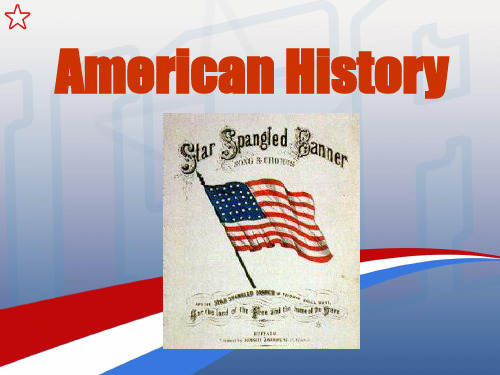
Relations of American Indians with European settlers
• friendship
• American Indians helped the early Europeans to survive
• hostility
• American Indians were killed and driven to mountainous and barren areas known as Indian Reservations, as a result of interests in land and cultural conflicts
Stamp Act
• 印花税,是税的一种,是对合同、凭证、 书据、账簿及权利许可证等文件征收的税 种。纳税人通过在文件上加贴印花税票, 或者盖章来履行纳税义务。
Tea Act
• The British government allowed the company to sell tea at lower price in the colonies through its own people. This took away the tea business from American tea merchants.
– The British government was to bring the development under control and to collect more taxes from the colonies. – ―No taxation without representation‖ – ( 无代表, 不纳税)
Washington. The Declaration of Independence
American historys 美国历史精讲 英语国家概况
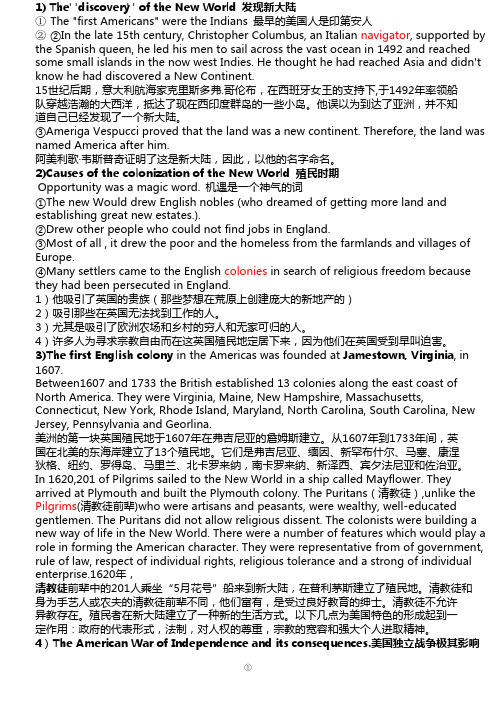
1) The "discovery" of the New World 发现新大陆①The "first Americans" were the Indians 最早的美国人是印第安人②②In the late 15th century, Christopher Columbus, an Italian navigator, supported by the Spanish queen, he led his men to sail across the vast ocean in 1492 and reached some small islands in the now west Indies. He thought he had reached Asia and didn't know he had discovered a New Continent.15世纪后期,意大利航海家克里斯多弗.哥伦布,在西班牙女王的支持下,于1492年率领船队穿越浩瀚的大西洋,抵达了现在西印度群岛的一些小岛。
他误以为到达了亚洲,并不知道自己已经发现了一个新大陆。
③Ameriga Vespucci proved that the land was a new continent. Therefore, the land was named America after him.阿美利歌·韦斯普奇证明了这是新大陆,因此,以他的名字命名。
2)Causes of the colonization of the New World 殖民时期Opportunity was a magic word.机遇是一个神气的词①The new Would drew English nobles (who dreamed of getting more land and establishing great new estates.).②Drew other people who could not find jobs in England.③Most of all , it drew the poor and the homeless from the farmlands and villages of Europe.④Many settlers came to the English colonies in search of religious freedom because they had been persecuted in England.1)他吸引了英国的贵族(那些梦想在荒原上创建庞大的新地产的)2)吸引那些在英国无法找到工作的人。
英美概况考试重点整理 美国史
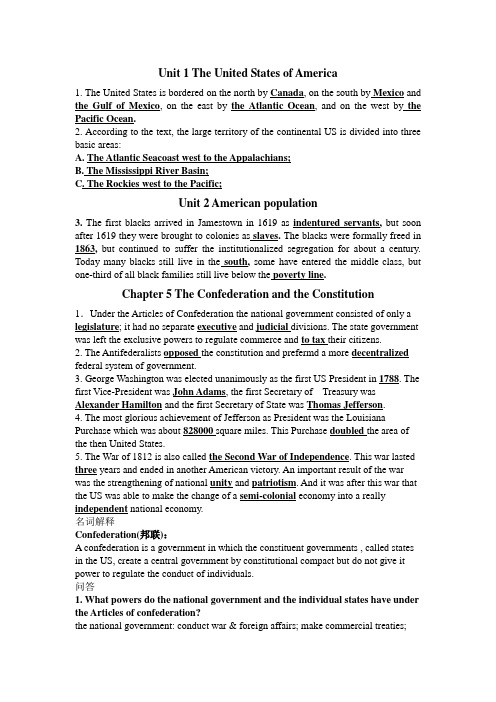
Unit 1 The United States of America1. The United States is bordered on the north by Canada, on the south by Mexico and the Gulf of Mexico, on the east by the Atlantic Ocean, and on the west by the Pacific Ocean.2. According to the text, the large territory of the continental US is divided into three basic areas:A. The Atlantic Seacoast west to the Appalachians;B. The Mississippi River Basin;C. The Rockies west to the Pacific;Unit 2 American population3. The first blacks arrived in Jamestown in 1619 as indentured servants, but soon after 1619 they were brought to colonies as slaves. The blacks were formally freed in 1863, but continued to suffer the institutionalized segregation for about a century. Today many blacks still live in the south, some have entered the middle class, but one-third of all black families still live below the poverty line.Chapter 5 The Confederation and the Constitution 1.Under the Articles of Confederation the national government consisted of only a legislature; it had no separate executive and judicial divisions. The state government was left the exclusive powers to regulate commerce and to tax their citizens.2. The Antifederalists opposed the constitution and prefermd a more decentralized federal system of government.3. George Washington was elected unanimously as the first US President in 1788. The first Vice-President was John Adams, the first Secretary of Treasury was Alexander Hamilton and the first Secretary of State was Thomas Jefferson.4. The most glorious achievement of Jefferson as President was the Louisiana Purchase which was about 828000 square miles. This Purchase doubled the area of the then United States.5. The War of 1812 is also called the Second War of Independence. This war lasted three years and ended in another American victory. An important result of the war was the strengthening of national unity and patriotism. And it was after this war that the US was able to make the change of a semi-colonial economy into a really independent national economy.名词解释Confederation(邦联):A confederation is a government in which the constituent governments , called states in the US, create a central government by constitutional compact but do not give it power to regulate the conduct of individuals.问答1. What powers do the national government and the individual states have under the Articles of confederation?the national government: conduct war & foreign affairs; make commercial treaties;negotiate with Indians; coin money & issue bills of creditthe individual states: deal with foreign countries; engage in war; issue money & bills of credit; collect taxesChapter6 American Expansion and the Civil War1.The essence of Monroe Doctrine was which later became the __cornerstone __of the US policy.2.Oregon territory was settled between Britain and the United States in_1846__.Its boundary on the north was fixed at the _forty--ninth_parallel of north latitude.3.Under Missouri Compromise,Missouri was admitted as a _slave_state,but the balance of political power maintained by admission of _Maine_as a_free_state.In addition,slavery was to be prohibited in the rest of Louisiana Territory north of the line_36°30’_ parallel.4.In 1862,the federal government took two revolutionary measures:(1)Homestead Act and(2)Emancipation Proclamation.5.In July 1863 came the turning point of of the war at Gettysburg.Here the Confederate army under the general Robert E.Lee was defeated.The battlefield was made a national cemetery,where Lincoln gave his famous speech,the Gettysburg Address on November 19,1863.6.In 1865,the Thirteenth Amendment to the US Constitution was adopted,which abolished slavery throughout the United States.问答1.What was the Monroe Doctrine?The Monroe Doctrine written by James Monroe, declared in December of 1823, was a superlative U.S. foreign policy statement. It was precipitated by various independence movements in South America and the U.S. government's desire to discourage European nations from colonizing the Americas, and a growing American nationalism.The Monroe Doctrine stated that European nations should not intervene in countries to the south of the U.S. Finally, it promised to stay out of foreign affairs.U.S. will not interfere with European affairs in Europe.The essence of the Doctrine is“America for Americans”.Whic h later became a cornerstone of the US foreign policy.As the New World developed in the years ahead this doctrine became more meaningful and was strengthened by a border interpretation to meet the needs of an energetic and ambitious United States.名词解释1.Gettysburg AddressThe Gettysburg Address is a speech delivered by U.S. President Abraham Lincoln during the American Civil War on November 19, 1863 after the northern victory at Gettysburg.It is regarded as one of the most significant expressions of American democracy. In just over two minutes, Lincoln reiterated the principles of human equality espoused by the Declaration of Independence and proclaimed the Civil War as a struggle for the preservation of the Union sundered by the secession crisis,with "a new birth of freedom,"that would bring true equality[5] to all of its citizens.Lincoln also redefined the Civil War as a struggle not just for the Union, but also for theprinciple of human equality.Chapter 7 Reconstruction and the Birth of Us Imperialism1、The Reconstruction Acts divided all the former confederate states, exceptTennessee, into five military districts and each was put under the control of a Northern army officer. The officer had the power to keep order and to enforce martial law if necessary.2、During the Reconstruction the Southern whites who supported the radicalreconstruction and joined the Republican Party were called scalawags. They were considered as traitors by the Southern Democrats.3、The KKK, founded in Tennessee in 1866, was a secret society for resortingwhite supremacy and driving blacks out of politics.名词解释Open Door PolicyIn Sino-American relations, Theodore Roosevelt pushed the so- called “Open Door Policy” which demanded that all the imperialist powers should enjoy equal chance in China as freely as othe r aggressors.Chapter 8 world war I and the depression1、The First World War was waged between two groups of imperialist powers: the Allies and the Central European Power.2、The direct cause that made the US declare war on Germany in 1917 was the Germany’s unlimited submarine campaign.3、The major triumph for Wilson at the Paris Peace Conference was the formation of the League of Nations.4、The United States didn’t join the League of Nations because the US Senate refused to approve the Treaty of Versailles.5、The Great Depression started with the sudden collapse of the Stock Market in New York in October, 1929. This economic distress extended to Europe, Asia, Africa, Australia and South America.名词解释:Roaring Twenties: The ten years between 1919 and 1929, usually called the “Roaring Twenties” or the “Jazz Age”, were a time of carefree prosperity, isolation from the world’s problems, bewildering social change and a feverish pursuit of pleasure.问答题:1、Why did the US join the First World War so late?First, the United States was lack of military preparedness when the war began.Another factor for the US to join the war was the American financial and industrial commitment to the Allied cause,F inally the factor that pushed the US into the war was Germany’s submarine campaign against merchant ships.2、What were the major contents and basic ideas of the New Deal? How do you comment on the New Deal?The aims of the New Deal were to raise commodity prices by limiting production,devaluing the dollar, maintaining high tariffs on foreign goods, and to carry through a modest inflation by providing money at low rates of interest to farmers and to industry.For farmers, the Agricultural Adjustment Act was passed in 1933, which enabled the government, among other things, to pay grants to induce them to reduce the amount of products, which included such commodities as cotton, wheat, corn, pigs, rice, tobacco, milk, sugar and others.In industry Roosevelt, by the National Recovery Act of 1933, was given power to control working conditions, and to fix minimum wages.Chapter 9 American During and After World II1.The cash-and-carry policy allowed US citizens to_sell___ certain nonprohibitedgoods to belligerent nations as long as those goods were not transported on _American_ ships.2.Stars Wars program was proposed by President _Reagan_in __1983__. Theprogram seeks to construct a defensive “shield”against incoming _missiles_.The shield would be made of _laser__ and electronic _devices _that would destroy such missiles launched to attack _ the US__名词解释1.The Cold WarDuring the time 1945-1991, because disagreed about the configuration of the post-war world, especially about that of Europe, there was a continuing state of political and military tension between the powers of the Western world, led by the U.S., and the communist world, led by the USSR. The Cold War was ended with the dissolution of the USSR in 1991.2.The Truman Doctrinea policy by Truman on Mar. 12, 1947 stating that the U.S. would support Greece and Turkey with economic and military aid ($400m) to prevent their falling into the Soviet sphere. It was the start of the Cold War and the start of the containment policy to stop Soviet expansion. . It became the basis of U.S. Cold War policy throughout Europe and around the world.3.Marshall PlanThe economic equivalent of the containment policy was presented by secretary of state George Marshall, called Marshall plan. It was in operation for four years beginning in April 1948. the purpose of the plan was to modernize European industrial and business practices using high-efficiency American models, reduce artificial trade barriers, and instill a sense of hope and self-reliance. (The U.S. gave monetary support to help rebuild European economies to combat the spread of communism.) the plan had two major aims:(1)to keep communists out of political power in Europe. (2)to stabilize the international economic order in a way favorableto capitalism. It was one of the first elements of European integration问答1.What are the major forms of American Civil Rights Movement from 1955 to 1968?Can you give one specific examples?Boycotts; Sit-ins;Montgomery Bus Boycott (1955-1956)●On Dec. 1, 1955, Rosa Parks refused to give up her seat on a public bus tomake room for a white passenger, and then Parks was arrested, tried, and convicted for disorderly conduct and violating a local ordinance.After word of this incident reached the black community, 50 African-American leaders gathered and organized the Montgomery Bus Boycott to demand a more humane bus transportation system.90% of African Americans in Montgomery partook in the boycotts, which reduced bus revenue by 80% until a federal court ordered Montgomery's buses desegregated in Nov. 1956, and the boycott ended.●Chapter 10 The Federal System and Congress1.Federalism means the division of powers by a constitution between the centralgovernment and state government. It operates only on two levels, the national and the state . Units of government within a state enjoy no independent existence. 2.Separation of powers in the United States means not only allocating legislativepower to Congress, executive power to President and judicia l power to the Supreme Court, but also giving each branch constitutional and political independence and checks and balances that ensure each of the three branchesa sufficient role in the actions of the others.3.According to the Constitution, members of the House of Representatives must be25 years old and must have been citizens for 7 years. Senators must be at least 30and must have been citizens for 9 years.4.The Vice President is officially the presiding officer and is called the presidentof the Senate. In fact he seldom appears in the Senate chamber in this role unless it appears that there might be tie vote in the Senate. In such instances, he casts the tiebreaking vote. To deal with day-to-day business, the Senate chooses the president pro tempore.名词解释1 federalism: This division of powers by a constitution between the national government and state government.2 separation of powers: It means constitutional division of powers between the legislative, executive, and judicial branches回答问题What are the three basic principles of U.S political system?The US political system was established on the basis of the three main principles-----federalism, separation of powers, and supremacy of the constitution. Federalism is the division of powers by a constitution between the national government and state government. It should be observed that federalism operates only on two levels, the national and the state .Separation of powers means constitutional division of powers between the legislative, executive, and judicial branches. It meansmore than allocating legislative power to the Supreme Court. It also means giving each branch constitutional and political independence and checks and balances that ensure each of the three branches a sufficient role in the actions of the others so that no one branch may dominate the others. Supremacy of the constitution means that every American citizen is required to respect the Constitution and to obey the laws of the United StatesChapter 11The President and the Judiciary1 By law any natural-born American citizen of and over 35 years of age and ofbeing a resident within the United States for 14 years can run for thepresident .The duly elected and duly qualified president-elect takes office on the 20th of January following his election.2 The Supreme Court has the power to examine the bills passed by Congress andpolicies made by President, and declare them unconstitutional and thus abolish them. John Marshall, the most famous chief justice (1801-1835) in Americahistory, called this power of interpretation judicial review.3 There are three federal court levels: 1) the district courts, 2) the courts ofappeal, 3) the Supreme Cour t. All the judges of federal courts appointed byPresident with the consent of the Senate. The state court system also has ahierarchy of three levels: 1) superior cour ts, 2) appellate courts 3)a statesupreme court. The state court judges are usually elected. The term of the county court judges is usually four years. And the judges in higher state courts usually serve eight or twelve years for one term.问答How is the president’s power limitedThe president has no power to declare war on other countries. He can call Congress into special session and can adjourn Congress, but he cannot dismiss Congress. He cannot pardon the person who is impeached. All appropriations of the government are legislated by Congress. The Supreme Court has the power to declare the pr esident’s policy, even if it has already been approved by Congress, unconstitutional and thus abolished it. If the president abuses his power or commits crimes, he will be impeached by Congress.Chapter 12 Political Parties and ElectionThe candidate with the most votes in a state wins all of that state’s electoral votes. This is known as the “winter-take-all” principle. The candidate who wins the majority of the 538 Electoral College votes will be the US President in the next four years.名词解释Election Day: the day set by law for the general elections of public officials. It occurs on the Tuesday after the first Monday in November. (The earliest possible date is November 2 and the latest possible date is November 8.)Winner-take-al l:The candidate with the most votes in a state wins all of that state’selectoral votes.问答题How is the U.S. president elected?First stage: the major parties hold conventions to choose candidates for President and Vice President and to determine the parties’ platforms.Second stage: the campaigning stage. From early fall of the election year to Election Day, candidates travel across the country and deliver countless speeches, campaigning for support.Third stage: voters to choose a slate of president electors in their state who make up the Electoral College. The candidate with the most votes will be the President in the next four years.Fourth stage: when the new Congress assembled on Jan. 6, the electoral votes are formally counted in a joint session of the two houses and the President of the Senate announces the “state of the vote”. If there’s no electoral college winner, the house of representatives choose the president.。
美国历史中英文简介

美国历史中英文简介一、美国历史介绍,要英文版的~在线等United States officially United States of AmericaFederal republic, North America.It prises 48 contiguous states occupying the mid-continent, Alaska at the northwestern extreme of North America, and the island state of Hawaii in the mid-Pacific Ocean. The U.S. is a republic with two legislative houses; its head of state and government is the president. The territory was originally inhabited for several thousand years by numerous American Indian peoples who had probably emigrated from Asia. European exploration and settlement from the 16th century began displacement of the Indians. The first permanent European settlement, by the Spanish, was at Saint Augustine, Fla., in 1565; the British settled Jamestown, Va. (1607); Plymouth, Mass. (1620); Maryland (1634); and Pennsylvania (1681). The British took New York, New Jersey, and Delaware from the Dutch in 1664, a year after the Carolinas had been granted to British noblemen. The British defeat of the French in 1763 (see French and Indian War) assured British political control over its 13 colonies. Political unrest caused by British colonial policy culminated in the American Revolution (1775–83) and the Declaration of Independence (1776). The U.S. was first anized under the Articles of Confederation (1781), then finally under the Constitution (1787) as a federal republic. Boundaries extended west to the Mississippi River, excluding Spanish Florida. Land acquired from France by the Louisiana Purchase (1803) nearly doubled the country's territory. The U.S. fought the War of 1812 against the British and acquired Florida from Spain in 1819. In 1830 it legalized removal of American Indians to lands west of theMississippi River. Settlement expanded into the Far West in the mid-19th century, especially after the discovery of gold in California in 1848 (see gold rush). Victory in the Mexican War (1846–48) brought the territory of seven more future states (including California and Texas) into U.S. hands. The northwestern boundary was established by treaty with Great Britain in 1846. The U.S. acquired southern Arizona by the Gadsden Purchase (1853). It suffered disunity during the conflict between the slavery-based plantation economy in the South and the free industrial and agricultural economy in the North, culminating in the American Civil War and the abolition of slavery under the 13th Amendment. After Reconstruction (1865–77) the U.S. experienced rapid growth, urbanization, industrial development, and European immigration. In 1877 it authorized allotment of American Indian reservation land to individual tribe ... en, resulting in widespread loss of land to whites. By the end of the 19th century, it had developed foreign trade and acquired outlying territories, including Alaska, Midway Island, the Hawaiian Islands, the Philippines, Puerto Rico, Guam, Wake Island, American Samoa, the Panama C ... Zone, and the Virgin Islands. The U.S. participated in World War I in 1917–18. It granted suffrage to women in 1920 and citizenship to American Indians in 1924. The stock market crash of 1929 led to the Great Depression. The U.S. entered World War II after the Japanese bombing of Pearl Harbor (Dec. 7, 1941). The explosion by the U.S. of an atomic bomb on Hiroshima (Aug. 6, 1945) and another on Nagasaki (Aug. 9, 1945), Japan, brought about Japan's surrender. Thereafter the U.S. was the military and economic leader of the Western world. 美国历史不是几句话就可以说完的,这已是压缩版,因为我是学历史的,可能觉得什么都很重要。
英美概况知识点总结

英美概况知识点总结英美概况是指英国和美国的综合概述,包括地理、历史、文化、经济等方面的内容。
以下将从不同角度对英美概况进行总结。
一、地理概况英国位于欧洲大陆西北部,包括大不列颠岛和北爱尔兰。
英格兰、苏格兰、威尔士和北爱尔兰是英国的四个组成部分。
英国是一个岛国,海洋对英国的经济和国际交流起着重要作用。
美国位于北美洲,东临大西洋,西靠太平洋,与加拿大和墨西哥为邻。
美国是世界第三大国家,拥有广袤的领土和多样的地理环境。
二、历史概况英国历史悠久,曾经是大不列颠帝国的核心。
英国是工业革命的发源地,对现代科技和工业发展做出了重要贡献。
美国的历史相对较短,于18世纪独立建国。
美国是一个移民国家,吸引了来自世界各地的移民,形成了多元文化的社会。
三、文化概况英国文化深厚,包括文学、音乐、戏剧等方面的成就。
莎士比亚、狄更斯、奥斯卡·王尔德等众多文化名人出自英国。
英国的摇滚乐、流行音乐也享誉世界。
美国文化的影响力也非常大,好莱坞电影、流行音乐、美式足球等都深受全球喜爱。
美国文学也有众多杰出作品,如马克·吐温的《哈克贝利·费恩历险记》和弗朗西斯·斯科特·菲茨杰拉德的《了不起的盖茨比》。
四、经济概况英国是世界上最发达的资本主义国家之一,金融业和服务业发达。
伦敦作为国际金融中心,具有重要的地位。
美国是全球最大的经济体,以市场经济为基础,拥有世界上最发达的科技和创新产业。
美国是世界上最大的农产品生产国和第二大制造业国。
总结起来,英美概况涵盖了地理、历史、文化和经济等方面的内容。
英国和美国都是世界上具有重要影响力的国家,对世界的发展有着重要的贡献。
两个国家在不同领域都有独特的优势和特色,值得我们进一步深入了解和学习。
英美概况美国部分(修正版)

英美概况:美国部分美国是一个世界强国,也是世界上最发达的国家之一。
它是全球第三大面积的国家,也是人口最多的发达国家之一。
在全球政治、经济、文化和科技等多个方面都具有重要影响力。
本文将介绍美国的基本概况,包括历史、政治、经济、文化等方面的信息。
历史美国的历史可以追溯到17世纪初。
当时,欧洲人开始在美洲殖民,最初的定居点之一是弗吉尼亚州的詹姆斯敦。
在接下来的几个世纪里,欧洲的殖民者不断向西扩张,逐渐控制了整个北美洲。
在18世纪末,美国独立战争爆发,美国成功地获得了独立。
之后,美国逐步成为一个强大的国家,经历了艰苦的内战、两次世界大战、冷战等重要时期。
如今,美国已经发展成为一个全球超级大国。
政治美国是一个联邦共和制国家,由50个州和华盛顿特区组成。
美国的总统是国家最高领导人,其它重要政治职位包括国务卿、众议院议长、参议院议长等。
美国的政治体系强调三权分立,即立法、行政和司法。
除了国家政府外,各个州和地方政府也有很大的自治权力。
例如,州政府负责管理其内部的基础设施、教育、警力等方面的事务。
经济美国是世界上最大的经济体之一,并拥有世界上最先进的市场经济体系。
其国内生产总值(GDP)约为21万亿美元,占据了全球总GDP的近四分之一。
美国的经济以服务业和制造业为主。
其中,科技产业是美国经济的一个重要支柱,硅谷和纽约市的科技企业在全球范围内都有重要影响力。
美国的贸易额也非常高,是世界上最大的进口国和第二大出口国。
文化美国文化是世界上最多元化的文化之一,其核心价值包括自由、民主和平等。
美国拥有世界最顶尖的大学、艺术机构和博物馆,其中包括哈佛大学、纽约大都会艺术博物馆、洛杉矶县艺术博物馆等。
美国的音乐和电影产业也非常有名,好莱坞电影更是成为了世界的一张名片。
在日常生活中,美国人非常注重个人隐私和自由,热爱户外运动和旅游。
他们吃的食物和所喜欢的体育运动都各具特色,如热狗、汉堡包、冰淇淋、棒球等。
美国是一个多元化的国家,拥有着丰富的历史、政治、经济和文化。
《英语国家概况》各章节概要知识点——美国部分
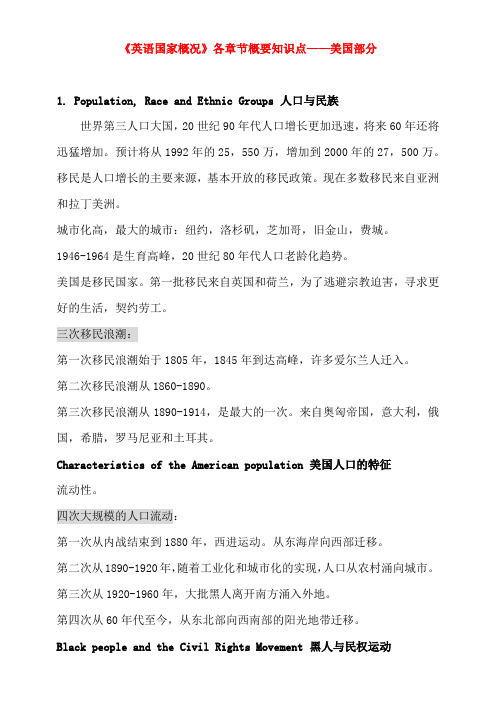
《英语国家概况》各章节概要知识点——美国部分1. Population, Race and Ethnic Groups 人口与民族世界第三人口大国,20世纪90年代人口增长更加迅速,将来60年还将迅猛增加。
预计将从1992年的25,550万,增加到2000年的27,500万。
移民是人口增长的主要来源,基本开放的移民政策。
现在多数移民来自亚洲和拉丁美洲。
城市化高,最大的城市:纽约,洛杉矶,芝加哥,旧金山,费城。
1946-1964是生育高峰,20世纪80年代人口老龄化趋势。
美国是移民国家。
第一批移民来自英国和荷兰,为了逃避宗教迫害,寻求更好的生活,契约劳工。
三次移民浪潮:第一次移民浪潮始于1805年,1845年到达高峰,许多爱尔兰人迁入。
第二次移民浪潮从1860-1890。
第三次移民浪潮从1890-1914,是最大的一次。
来自奥匈帝国,意大利,俄国,希腊,罗马尼亚和土耳其。
Characteristics of the American population 美国人口的特征流动性。
四次大规模的人口流动:第一次从内战结束到1880年,西进运动。
从东海岸向西部迁移。
第二次从1890-1920年,随着工业化和城市化的实现,人口从农村涌向城市。
第三次从1920-1960年,大批黑人离开南方涌入外地。
第四次从60年代至今,从东北部向西南部的阳光地带迁移。
Black people and the Civil Rights Movement 黑人与民权运动黑人是美国人口最多的少数民族。
自1619年作为奴隶贩运到北美洲,集中在南部农业区,生活悲惨。
代表小说《汤姆叔叔的小屋》和《根》。
1863年林肯的《解放奴隶宣言》和1865《宪法》第13条修正案正式结束了奴隶制,但仍存在歧视。
1954年布朗诉教育委员会一案,开始了漫长的废除种族隔离的进程。
60年代爆发民权运动。
1964年通过《民权法案》,1965年通过《选举权法案》。
英美概况知识点总结

英美概况1. 概述英美是指英国和美国,两个国家在历史、文化、经济等方面有着紧密的联系。
英国是位于欧洲的一个岛国,拥有悠久的历史和文化传统;美国是位于北美洲的一个大陆国家,是世界上最强大的经济体之一。
2. 历史背景2.1 英国历史英国的历史可以追溯到公元前1万年左右的旧石器时代。
公元43年,罗马帝国入侵不列颠岛,并建立了不列颠罗马省。
5世纪时,盎格鲁-撒克逊人开始从欧洲大陆迁徙至不列颠岛,建立了各个王国。
9世纪时,威塞克斯王朝统一了英格兰。
1066年,诺曼底公爵威廉一世在哈斯丁斯战役中击败了英格兰的哈罗德二世,并建立了诺曼底王朝。
14世纪后期,英法百年战争爆发,在这场战争中英格兰失去了大部分法国领土。
16世纪初,亨利八世发动宗教改革,英格兰成为新教国家。
17世纪中期,英国爆发了内战,最终奥利弗·克伦威尔夺取政权并建立了共和国。
1660年,英国恢复君主制。
18世纪后期至19世纪初期,工业革命在英国兴起,使其成为当时的工业中心。
19世纪时,英国成为世界上第一个工业化的国家,并在全球范围内建立了庞大的殖民帝国。
2.2 美国历史美洲大陆最早的居民是印第安人。
1492年,哥伦布发现了美洲大陆,并开启了欧洲人对美洲的探索和殖民活动。
17世纪初,英格兰开始向北美洲殖民,并建立了13个殖民地。
这些殖民地于1776年宣布独立,成立了美利坚合众国。
19世纪初至中期,美国经历了西部拓荒运动、南北战争等重要事件。
南北战争结束后,废除奴隶制度,美国逐渐工业化和现代化。
20世纪初至中期,美国崛起为世界上最强大的经济体之一。
两次世界大战后,美国成为超级大国,并在冷战时期与苏联展开了长达几十年的对抗。
3. 政治制度3.1 英国政治制度英国是一个君主立宪制国家,君主是英国的元首,但权力受到议会的限制。
议会分为上议院和下议院,下议院中的议员由选举产生。
英国政府由内阁和首相领导。
首相通常来自于执政党的领袖。
英国政治体系注重权力分立和民主原则。
american history美国历史简介(总结自托福词以类记)
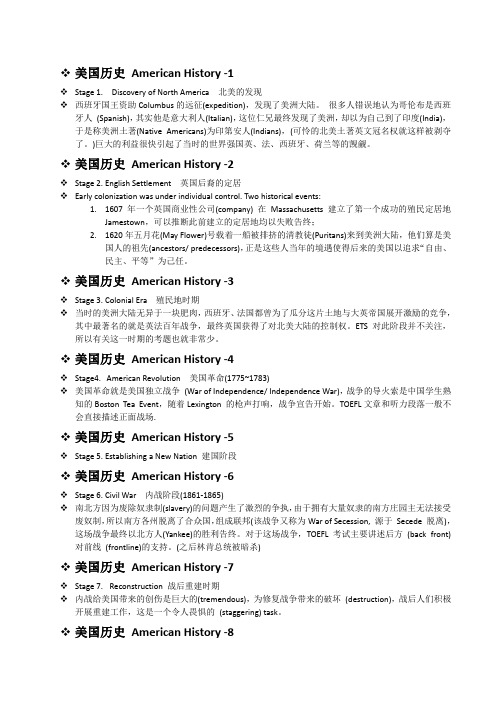
美国历史American History -1Stage 1. Discovery of North America 北美的发现西班牙国王资助Columbus的远征(expedition),发现了美洲大陆。
很多人错误地认为哥伦布是西班牙人(Spanish),其实他是意大利人(Italian),这位仁兄最终发现了美洲,却以为自己到了印度(India),于是称美洲土著(Native Americans)为印第安人(Indians),(可怜的北美土著英文冠名权就这样被剥夺了。
)巨大的利益很快引起了当时的世界强国英、法、西班牙、荷兰等的觊觎。
美国历史American History -2Stage 2. English Settlement 英国后裔的定居Early colonization was under individual control. Two historical events:1.1607年一个英国商业性公司(company) 在Massachusetts 建立了第一个成功的殖民定居地Jamestown,可以推断此前建立的定居地均以失败告终;2.1620年五月花(May Flower)号载着一船被排挤的清教徒(Puritans)来到美洲大陆,他们算是美国人的祖先(ancestors/ predecessors),正是这些人当年的境遇使得后来的美国以追求“自由、民主、平等”为己任。
美国历史American History -3Stage 3. Colonial Era 殖民地时期当时的美洲大陆无异于一块肥肉,西班牙、法国都曾为了瓜分这片土地与大英帝国展开激励的竞争,其中最著名的就是英法百年战争,最终英国获得了对北美大陆的控制权。
ETS对此阶段并不关注,所以有关这一时期的考题也就非常少。
美国历史American History -4Stage4.American Revolution美国革命(1775~1783)美国革命就是美国独立战争(War of Independence/ Independence War),战争的导火索是中国学生熟知的Boston Tea Event,随着Lexington 的枪声打响,战争宣告开始。
American History 英美概况美国历史
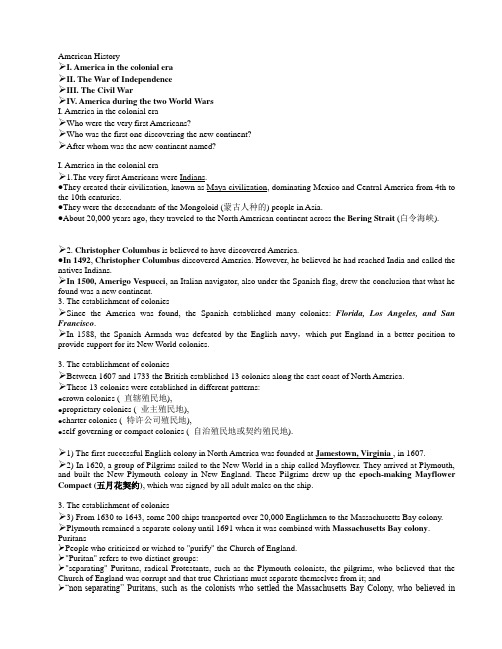
American History➢I. America in the colonial era➢II. The War of Independence➢III. The Civil War➢IV. America during the two World WarsI. America in the colonial era➢Who were the very first Americans?➢Who was the first one discovering the new continent?➢After whom was the new continent named?I. America in the colonial era➢1.The very first Americans were Indians.●They created their civilization, known as Maya civilization, dominating Mexico and Central America from 4th to the 10th centuries.●They were the descendants of the Mongoloid (蒙古人种的) people in Asia.●About 20,000 years ago, they traveled to the North American continent across the Bering Strait (白令海峡).➢2. Christopher Columbus is believed to have discovered America.●In 1492, Christopher Columbus discovered America. However, he believed he had reached India and called the natives Indians.➢In 1500, Amerigo Vespucci, an Italian navigator, also under the Spanish flag, drew the conclusion that what he found was a new continent.3. The establishment of colonies➢Since the America was found, the Spanish established many colonies: Florida, Los Angeles, and San Francisco.➢In 1588, the Spanish Armada was defeated by the English navy,which put England in a better position to provide support for its New World colonies.3. The establishment of colonies➢Between 1607 and 1733 the British established 13 colonies along the east coast of North America.➢These 13 colonies were established in different patterns:●crown colonies ( 直辖殖民地),●proprietary colonies ( 业主殖民地),●charter colonies ( 特许公司殖民地),●self-governing or compact colonies ( 自治殖民地或契约殖民地).➢1) The first successful English colony in North America was founded at Jamestown, Virginia , in 1607.➢2) In 1620, a group of Pilgrims sailed to the New World in a ship called Mayflower. They arrived at Plymouth, and built the New Plymouth colony in New England. These Pilgrims drew up the epoch-making Mayflower Compact (五月花契约), which was signed by all adult males on the ship.3. The establishment of colonies➢3) From 1630 to 1643, some 200 ships transported over 20,000 Englishmen to the Massachusetts Bay colony. ➢Plymouth remained a separate colony until 1691 when it was combined with Massachusetts Bay colony. Puritans➢People who criticized or wished to "purify" the Church of England.➢"Puritan" refers to two distinct groups:➢"separating" Puritans, radical Protestants, such as the Plymouth colonists, the pilgrims, who believed that the Church of England was corrupt and that true Christians must separate themselves from it; and➢“non-separating” Puritans, such as the colonists who settled the Massachusetts Bay Colony, who believed inreform but not separation.Puritans➢(1) Puritans believed that God had set special duties for everyone to carry out.➢(2) These puritans were well known for their spirit of enterprise and high standard of morality.➢(3) Puritans advocated thriftiness in doing things and rejected all church rituals. They demanded equality and opposed all priestly hierarchy.Puritans➢(4) They believed it was noble to protect human rights in their pursuit of wealth.➢(5) Puritans placed great importance on education and founded Harvard College in 1636. Most of the Puritans were well-educated and wealthy.Puritans3. The establishment of colonies➢4) The Rhode Island Colony was founded by dissenters pushed out of Massachusetts.➢5) The other four colonies: the Connecticut Colony, the New Hampshire colony, Maine, Vermont comprises the region, known as New England.3. The establishment of colonies➢The New Englanders, despite their differences, mostly belong to the Puritan group in religion. Their values include the belief in hard work, thriftiness, accumulation of wealth, self-government, acquisitiveness, and Puritanic morality. Their culture laid the foundation of American values and became the American mainstream culture. And New England has been regarded as the cradle of American democracy.3. The establishment of colonies➢6) New York and New Jersey were first colonized by the Dutch while Delaware was founded by the Swedish. These three colonies were later taken over by the English Crown as crown colonies.3. The establishment of colonies➢7) Pennsylvania was founded by William Penn. Pen n set up a colony, Pennsylvania, meaning “Penn’s wood”. He adopted a tolerant policy which welcomed any settlers who read the Bible and believed in God. Pennsylvania later played an active role in fighting for America’s independence and against the slave s ystem in the South.3. The establishment of colonies➢8) The other colonies were Maryland, South and North Carolinas, and Georgia.➢So, by 1773, English settlers had occupied 13 colonies along the Atlantic coast.4. Features of American culture:➢1) a blending of European cultures under new circumstances in the New World➢2) less formal but more pragmatic, less conservative and more outspoken;➢3) hard-work, diligence, religious tolerance, respect of individual rights●(people of different national origi ns required social life to show toleration; not interfering in others’ privacy; problems concerning belief became a private affair)➢4) attaching great importance to education●founding Harvard College in Massachusetts 1636 by the Puritans with the original idea of enabling people to read Bible and communicate with God.➢Who were the very first Americans?➢Who is believed to have discovered America?➢After whom America was named?➢Which was the first successful English colony in North America?➢Which was New England comprised of?➢Which were the first 13 colonies along the Atlantic coast?II. The War of Independence➢1. Background➢1) The French and Indian War (The Seven Years’ War, 1756-1763)●The war first broke out in America between French and England, both of which claimed the Ohio River valley.●In 1754, the English colonists started to attack the French troops in this region and this touched off the French and Indian War.●The War, officially declared in Europe in 1756, was also known in Europe as the Seven Years’ War. Many countries in Europe were involved in the war.●Finally, France failed. The French had to sign the 1763 Treaty of Paris and ceded Canada to Britain.➢2) Conflict between England and its colonies:●England imposed new taxes partly in order to defray the cost of fighting the Seven Years’ War, and expected Americans to lodge British soldiers in their homes. The colonists resented the taxes and resisted the quartering of soldiers.●In 1765, the Stamp Act was passed by the English Parliament.●The Act was aiming to collect more taxes from the colonists, which made many colonists unhappy because they were not given a single seat to voice their feelings in the English Parliament at that time, so they raised the slogan of “no taxation without representation”.➢The direct cause: The Boston Tea Party●Because of import duties on tea, many merchants smuggled tea from Holland, instead of importing from England.●In order to deal with the rotting tea in the London warehouses and make more profits, the East India Company,a vital source of British wealth, was allowed by the British Government to sell its tea to the colonies free of import duty.●Colonial merchants were enraged and protested against the unequal treatment. On December 16, 1773, a band of50 men disguised as Indians and led by Samuel Adams dumped 90,000 pounds tea of three British tea-bearing ships lying at anchor in Boston Harbor, worth 90,000 pounds.➢3) the First Continental Congress●In September 1774●held in Philadelphia which encouraged Americans to refuse to buy British goods➢2. process➢1) the first shots●On April 19, 1775, 700 British soldiers were sent to Concord to search for weapons and “rebellious” colonists. When the troops reached Lexington at dawn, they encountered militiamen.●Fighting broke out and the first shots in the American War of Independence were fired.➢2) the Second Continental Congress➢In May, 1775➢held in Philadelphia and began to assume the functions of a national government.➢It founded the Continental Army and Navy under the command of George Washington.➢Thomas Jefferson drafted the Declaration of Independence, which the Congress adopted on July 4, 1776.➢The Declaration of Independence➢presenting a public defense of the American War of Independence➢a clear explanation of the political theory behind the revolution and this theory came from the British philosopher John Locke:●men have a natural right to “life, liberty and the pursuit of Happiness”; government can rule only with “theconsent of the governed”; any government may be dissolved when it fails to protect the rights of the people.●This theory is central to the western political tradition.➢3. Results●At first, the war went badly for the Americans.●After endless hard fighting, in October 1777, the Americans defeated the British troops at Saratoga 萨拉托加in Northern New York.●This was the turning point of the War, leading directly to an alliance between the U.S and France. (statue of liberty, 1886)●Finally, in 1783, the Treaty of Paris was signed, with which, the America won its independence.➢4. After the War of Independence➢1) problem➢How to convert the Confederation into Federation became a big problem for Americans.➢Because of different backgrounds and economic conditions, the 13 states were not closely united.●There were conflicts between radicals and moderates.●Moderates advocated a political economy based on a strong national government that would actively advance commerce and protect private property.●Radicals favoured a different political economy, based on a weaker central government, a more localized democracy, and a hand-off economic policy.➢2) the Constitutional Convention●On May 25, 1787●held in Philadelphia●Fifty-five delegates from all the states except Rhode Island attended the Convention.●These delegates were advocates of a united nation and had been active in the Revolution.●George Washington was elected chairman of the Convention.●James Madison from Virginia took the lead in the work to write a new constitution and he became known as “Father of the U. S. Constitution.”➢3) Federalist Papers 联邦文集●Prominent Federalists such as Alexander Hamilton, James Madison, and John Jay wrote 85 letters to the newspapers of New York, which were known as the Federalist Papers.●the best explanation of the constitution as well as one of the most important works on political theory➢4) the Bill of Rights人权法案➢The first ten amendments to the U.S Constitution, which was called the Bill of Rights, adopted in 1791 which promise to protect individuals' rights.●Freedom of religion, speech and the press;●The right to keep and bear arms;●The right against unreasonable searches and seizures;●The right against self-incrimination ( 自证其罪).。
英美概况American History
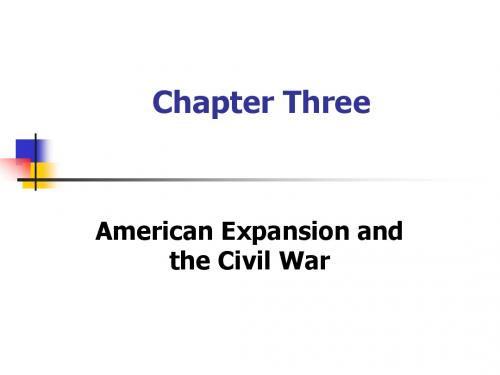
Gone with the Wind
The Win of the North
Richmond April-June,1865
1865, the south declared to defeat
Lincoln’s assassination
John Wilkes Booth, the murderer
Civil War (1861-1865)
Causes Process Significance
Economic Confrontation
The North The South
Provide raw materials for British factories
Import British industrial goods Planters own many slaves as their manpower
Union vs. Confederacy
The North
Population 2234万
The South
910万
Industry
Developed
Few
railroads
many
Nearly zero
Military
Not well equipped
Fully armed
Process of Civil War
Harriet Beecher Stowe (1861--1896)
So this is the lady who started the Civil War.
-- Abraham Lincoln
Sold 300,000 copies in the first year. 2 million in a decade!
英美概况history知识点总结

英美概况history知识点总结英美概况历史知识点总结英美是世界上两个最具影响力的国家之一,其悠久的历史和丰富的文化传统吸引着全世界的关注。
英美的历史可以追溯到几个世纪以前,经历了很多波折和变迁。
下面对英美的历史知识点进行总结,以便更好地了解这两个国家的过去和现在。
1. 古代历史英美的古代历史可以追溯到数千年前。
在古代,这两个地区都曾是众多古代文明的发源地,如古埃及文明、古希腊罗马文明、古印度文明等。
在这个时期,英美地区都有着独特的文化和历史传统,这些传统对今天的英美社会仍然产生了深远的影响。
2. 中世纪历史中世纪是英美历史中一个重要的时期。
在这个时期,这两个地区经历了诸多重大事件和变化。
在英国,威廉征服者的入侵、百年战争、开罗伍尔斯基等事件都对英国的政治、经济和社会产生了深远的影响。
在美国,南北战争、殖民地时期等事件也是这个时期的重要内容。
3. 近代历史近代英美历史以工业革命为标志。
工业革命的兴起给英美社会带来了翻天覆地的变化。
工业革命带来了科学技术的进步,同时也对社会产生了深远影响。
在英国,工业革命使其成为了世界上最强大的帝国之一,同时也带来了一系列社会问题。
在美国,工业革命推动了美国成为世界强国,同时也带来了新的挑战和机遇。
4. 现代历史20世纪是英美历史中一个重要的时期。
在这个时期,两国经历了两次世界大战、冷战等重大事件。
在这个时期,英美两国都成为了世界强国,其政治、经济、文化等方面都产生了深远的影响。
同时,这一时期也是英美关系的发展时期,两国在国际事务中扮演着举足轻重的角色。
5. 当代历史近年来,英美两国都经历了一系列重大事件和变革。
在英国,脱欧事件对英国政治和社会产生了深远的影响。
在美国,特朗普政府的执政、新冠疫情的爆发等事件也是这个时期的重要内容。
同时,两国在国际事务中的地位和角色也在发生变化,这对世界格局产生了深远影响。
总结英美的历史非常丰富多彩,其历史传统和文化遗产对人类文明和社会发展产生了深远的影响。
2023美国历史概况英文版
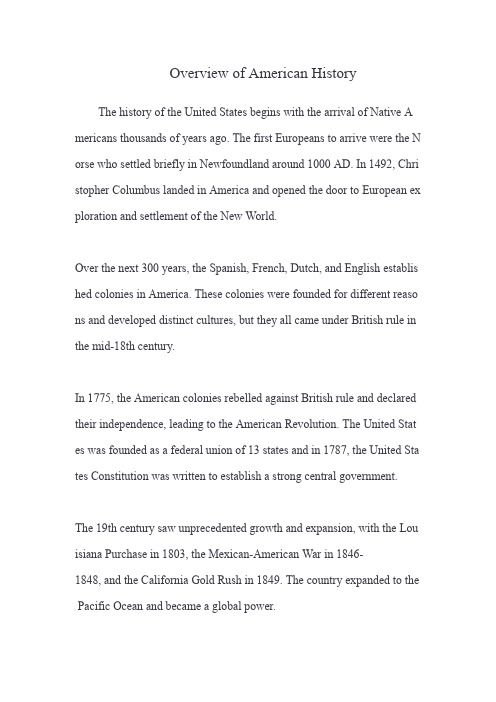
Overview of American HistoryThe history of the United States begins with the arrival of Native A mericans thousands of years ago.The first Europeans to arrive were the N orse who settled briefly in Newfoundland around1000AD.In1492,Chri stopher Columbus landed in America and opened the door to European ex ploration and settlement of the New World.Over the next300years,the Spanish,French,Dutch,and English establis hed colonies in America.These colonies were founded for different reaso ns and developed distinct cultures,but they all came under British rule in the mid-18th century.In1775,the American colonies rebelled against British rule and declared their independence,leading to the American Revolution.The United Stat es was founded as a federal union of13states and in1787,the United Sta tes Constitution was written to establish a strong central government.The19th century saw unprecedented growth and expansion,with the Lou isiana Purchase in1803,the Mexican-American War in1846-1848,and the California Gold Rush in1849.The country expanded to the Pacific Ocean and became a global power.The mid19th century saw the rise of sectionalism and the issue of slavery caused the nation to break apart into a Civil War between the North and S outh.The North emerged victorious and slavery was abolished,but the co untry faced the struggle of Reconstruction following the war.The20th century saw the United States become a world superpower,with involvement in World War I,World War II,the Cold War,the Korean Wa r,and the Vietnam War.The country also experienced social and political turmoil,including the civil rights movement,the feminist movement,and the counterculture movement.In recent years,the United States has faced challenges such as political po larization,economic inequality,and racial tensions,but also continues to be a leader in technology,innovation,and democracy.。
- 1、下载文档前请自行甄别文档内容的完整性,平台不提供额外的编辑、内容补充、找答案等附加服务。
- 2、"仅部分预览"的文档,不可在线预览部分如存在完整性等问题,可反馈申请退款(可完整预览的文档不适用该条件!)。
- 3、如文档侵犯您的权益,请联系客服反馈,我们会尽快为您处理(人工客服工作时间:9:00-18:30)。
American History➢I. America in the colonial era➢II. The War of Independence➢III. The Civil War➢IV. America during the two World WarsI. America in the colonial era➢Who were the very first Americans?➢Who was the first one discovering the new continent?➢After whom was the new continent named?I. America in the colonial era➢1.The very first Americans were Indians.●They created their civilization, known as Maya civilization, dominating Mexico and Central America from 4th to the 10th centuries.●They were the descendants of the Mongoloid (蒙古人种的) people in Asia.●About 20,000 years ago, they traveled to the North American continent across the Bering Strait (白令海峡).➢2. Christopher Columbus is believed to have discovered America.●In 1492, Christopher Columbus discovered America. However, he believed he had reached India and called the natives Indians.➢In 1500, Amerigo Vespucci, an Italian navigator, also under the Spanish flag, drew the conclusion that what he found was a new continent.3. The establishment of colonies➢Since the America was found, the Spanish established many colonies: Florida, Los Angeles, and San Francisco.➢In 1588, the Spanish Armada was defeated by the English navy,which put England in a better position to provide support for its New World colonies.3. The establishment of colonies➢Between 1607 and 1733 the British established 13 colonies along the east coast of North America.➢These 13 colonies were established in different patterns:●crown colonies ( 直辖殖民地),●proprietary colonies ( 业主殖民地),●charter colonies ( 特许公司殖民地),●self-governing or compact colonies ( 自治殖民地或契约殖民地).➢1) The first successful English colony in North America was founded at Jamestown, Virginia , in 1607.➢2) In 1620, a group of Pilgrims sailed to the New World in a ship called Mayflower. They arrived at Plymouth, and built the New Plymouth colony in New England. These Pilgrims drew up the epoch-making Mayflower Compact (五月花契约), which was signed by all adult males on the ship.3. The establishment of colonies➢3) From 1630 to 1643, some 200 ships transported over 20,000 Englishmen to the Massachusetts Bay colony. ➢Plymouth remained a separate colony until 1691 when it was combined with Massachusetts Bay colony. Puritans➢People who criticized or wished to "purify" the Church of England.➢"Puritan" refers to two distinct groups:➢"separating" Puritans, radical Protestants, such as the Plymouth colonists, the pilgrims, who believed that the Church of England was corrupt and that true Christians must separate themselves from it; and➢“non-separating” Puritans, such as the colonists who settled the Massachusetts Bay Colony, who believed inreform but not separation.Puritans➢(1) Puritans believed that God had set special duties for everyone to carry out.➢(2) These puritans were well known for their spirit of enterprise and high standard of morality.➢(3) Puritans advocated thriftiness in doing things and rejected all church rituals. They demanded equality and opposed all priestly hierarchy.Puritans➢(4) They believed it was noble to protect human rights in their pursuit of wealth.➢(5) Puritans placed great importance on education and founded Harvard College in 1636. Most of the Puritans were well-educated and wealthy.Puritans3. The establishment of colonies➢4) The Rhode Island Colony was founded by dissenters pushed out of Massachusetts.➢5) The other four colonies: the Connecticut Colony, the New Hampshire colony, Maine, Vermont comprises the region, known as New England.3. The establishment of colonies➢The New Englanders, despite their differences, mostly belong to the Puritan group in religion. Their values include the belief in hard work, thriftiness, accumulation of wealth, self-government, acquisitiveness, and Puritanic morality. Their culture laid the foundation of American values and became the American mainstream culture. And New England has been regarded as the cradle of American democracy.3. The establishment of colonies➢6) New York and New Jersey were first colonized by the Dutch while Delaware was founded by the Swedish. These three colonies were later taken over by the English Crown as crown colonies.3. The establishment of colonies➢7) Pennsylvania was founded by William Penn. Pen n set up a colony, Pennsylvania, meaning “Penn’s wood”. He adopted a tolerant policy which welcomed any settlers who read the Bible and believed in God. Pennsylvania later played an active role in fighting for America’s independence and against the slave s ystem in the South.3. The establishment of colonies➢8) The other colonies were Maryland, South and North Carolinas, and Georgia.➢So, by 1773, English settlers had occupied 13 colonies along the Atlantic coast.4. Features of American culture:➢1) a blending of European cultures under new circumstances in the New World➢2) less formal but more pragmatic, less conservative and more outspoken;➢3) hard-work, diligence, religious tolerance, respect of individual rights●(people of different national origi ns required social life to show toleration; not interfering in others’ privacy; problems concerning belief became a private affair)➢4) attaching great importance to education●founding Harvard College in Massachusetts 1636 by the Puritans with the original idea of enabling people to read Bible and communicate with God.➢Who were the very first Americans?➢Who is believed to have discovered America?➢After whom America was named?➢Which was the first successful English colony in North America?➢Which was New England comprised of?➢Which were the first 13 colonies along the Atlantic coast?II. The War of Independence➢1. Background➢1) The French and Indian War (The Seven Years’ War, 1756-1763)●The war first broke out in America between French and England, both of which claimed the Ohio River valley.●In 1754, the English colonists started to attack the French troops in this region and this touched off the French and Indian War.●The War, officially declared in Europe in 1756, was also known in Europe as the Seven Years’ War. Many countries in Europe were involved in the war.●Finally, France failed. The French had to sign the 1763 Treaty of Paris and ceded Canada to Britain.➢2) Conflict between England and its colonies:●England imposed new taxes partly in order to defray the cost of fighting the Seven Years’ War, and expected Americans to lodge British soldiers in their homes. The colonists resented the taxes and resisted the quartering of soldiers.●In 1765, the Stamp Act was passed by the English Parliament.●The Act was aiming to collect more taxes from the colonists, which made many colonists unhappy because they were not given a single seat to voice their feelings in the English Parliament at that time, so they raised the slogan of “no taxation without representation”.➢The direct cause: The Boston Tea Party●Because of import duties on tea, many merchants smuggled tea from Holland, instead of importing from England.●In order to deal with the rotting tea in the London warehouses and make more profits, the East India Company,a vital source of British wealth, was allowed by the British Government to sell its tea to the colonies free of import duty.●Colonial merchants were enraged and protested against the unequal treatment. On December 16, 1773, a band of50 men disguised as Indians and led by Samuel Adams dumped 90,000 pounds tea of three British tea-bearing ships lying at anchor in Boston Harbor, worth 90,000 pounds.➢3) the First Continental Congress●In September 1774●held in Philadelphia which encouraged Americans to refuse to buy British goods➢2. process➢1) the first shots●On April 19, 1775, 700 British soldiers were sent to Concord to search for weapons and “rebellious” colonists. When the troops reached Lexington at dawn, they encountered militiamen.●Fighting broke out and the first shots in the American War of Independence were fired.➢2) the Second Continental Congress➢In May, 1775➢held in Philadelphia and began to assume the functions of a national government.➢It founded the Continental Army and Navy under the command of George Washington.➢Thomas Jefferson drafted the Declaration of Independence, which the Congress adopted on July 4, 1776.➢The Declaration of Independence➢presenting a public defense of the American War of Independence➢a clear explanation of the political theory behind the revolution and this theory came from the British philosopher John Locke:●men have a natural right to “life, liberty and the pursuit of Happiness”; government can rule only with “theconsent of the governed”; any government may be dissolved when it fails to protect the rights of the people.●This theory is central to the western political tradition.➢3. Results●At first, the war went badly for the Americans.●After endless hard fighting, in October 1777, the Americans defeated the British troops at Saratoga 萨拉托加in Northern New York.●This was the turning point of the War, leading directly to an alliance between the U.S and France. (statue of liberty, 1886)●Finally, in 1783, the Treaty of Paris was signed, with which, the America won its independence.➢4. After the War of Independence➢1) problem➢How to convert the Confederation into Federation became a big problem for Americans.➢Because of different backgrounds and economic conditions, the 13 states were not closely united.●There were conflicts between radicals and moderates.●Moderates advocated a political economy based on a strong national government that would actively advance commerce and protect private property.●Radicals favoured a different political economy, based on a weaker central government, a more localized democracy, and a hand-off economic policy.➢2) the Constitutional Convention●On May 25, 1787●held in Philadelphia●Fifty-five delegates from all the states except Rhode Island attended the Convention.●These delegates were advocates of a united nation and had been active in the Revolution.●George Washington was elected chairman of the Convention.●James Madison from Virginia took the lead in the work to write a new constitution and he became known as “Father of the U. S. Constitution.”➢3) Federalist Papers 联邦文集●Prominent Federalists such as Alexander Hamilton, James Madison, and John Jay wrote 85 letters to the newspapers of New York, which were known as the Federalist Papers.●the best explanation of the constitution as well as one of the most important works on political theory➢4) the Bill of Rights人权法案➢The first ten amendments to the U.S Constitution, which was called the Bill of Rights, adopted in 1791 which promise to protect individuals' rights.●Freedom of religion, speech and the press;●The right to keep and bear arms;●The right against unreasonable searches and seizures;●The right against self-incrimination ( 自证其罪).。
